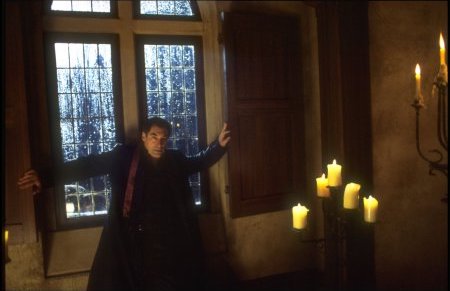
Possessed (2000) is a made for television film that was co-written and directed by Steven E. de Souza (best known for his work in the action movie genre) that adapts the same source material that inspired William Peter Blatty’s Exorcist novels and films. de Souza’s previous work as a director, Street Fighter (1994), may be the tonal and aesthetic opposite of Possessed but what the films do have in common are minuscule production budgets that necessitate a resourcefulness and degree of ingenuity that has always been amongst de Souza’s strengths.
In many ways the low budget of Possessed is its greatest asset. de Souza cannot hope to compete with William Friedkin as a stylistic, but by being forced to bathe his sets in deep shadow de Souza creates a kind of neo-gothic tableau around the demonic entity. This stratagem is coupled with various superimpositions as flashbacks that evoke the classic British horror films of the sixties. Friedkin’s iconoclasm is traded-in for a classicism that transforms the uneasiness inherent to the narrative into a safe space.
What de Souza’s classical approach to the material does is create a Brechtian distance between horror and spectator. The viewer is constantly aware of the artifice of Possessed because it maneuvers its plot through a labyrinth of easily recognizable and heavily codified symbols. Unpredictability is suggested in Possessed rather than adopted as its primary narrative mechanism; thus relegating the sense of actual danger into the background of the plot, rendering it a “safe” speace.
A similar approach is taken to the treatment of combat trauma. Timothy Dalton’s broad contortions and dramatic delivery of his lines paint a very theatrical portrait of survivor’s guilt. The melodrama of this trauma, derived from the post-war period of American cinematic history, is contemporaneous to the modus operandi of de Souza’s horror spectacles. Classicism is again the mode through which character and plot take shape in Possessed because of that idiom’s familiarity to the audience and the security that accompanies such a familiarity.
This agenda of adopting cinematographic aesthetics of the fifties and sixties to create marketable and approachable television content was often the norm amongst the better installments of this canon of tele-cinematic works. Today de Souza’s impulse to marry a contemporary sensibility to the formalism of the past may play as hackneyed camp to some, but it is actually a quite intriguing exercise in aesthetics. Although Possessed works as a film, it is not without its weaknesses. The script of Possessed, specifically the dialogue, does little to amplify the images or give the actors much to work with. Even an indomitable performer like Timothy Dalton is unable to elevate certain lines of dialogue. Some lines just seem to beg for a re-write or quick polish.
Possessed would not have worked as well as it does if de Souza wasn’t capable of working within the material limitations of his production. Too often otherwise acceptable television films of this era fell prey to over ambitious directing and unrealistic expectations of how far a modest illusion could be stretched.
